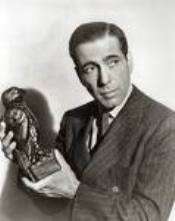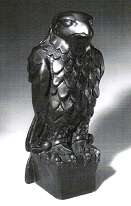The Maltese Falcon (novel)
The Maltese Falcon is a 1930 detective novel by American writer Dashiell Hammett, originally serialized in the magazine Black Mask beginning with the September 1929 issue. The story is told entirely in external third-person narrative; there is no description whatever of any character's internal thoughts or feelings, only what they say and do, and how they look. The novel has been adapted several times for the cinema.
.jpg) Cover of the first edition | |
| Author | Dashiell Hammett |
|---|---|
| Country | United States |
| Language | English |
| Genre | Detective fiction |
| Published | 1930 (Alfred A. Knopf) |
| Media type | Print (hardcover) |
| Preceded by | The Dain Curse |
| Followed by | The Glass Key |
The main character, Sam Spade (who also appeared later in some lesser-known short stories), was a departure from Hammett's nameless detective, The Continental Op. Spade combined several features of previous detectives, notably his cold detachment, keen eye for detail, unflinching, sometimes ruthless, determination to achieve his own form of justice, and a complete lack of sentimentality.
Plot
‘Sam’ Spade is a private detective in San Francisco, in partnership with Miles Archer. The beautiful "Miss Wonderley" hires them to follow Floyd Thursby, who has run off with her sister. Archer takes the first stint but is found shot dead that night. Thursby is also killed later and Spade is a suspect. The next morning, Spade coolly tells his office secretary, Effie Perine, to have the office door repainted to read simply "Samuel Spade".
"Miss Wonderley" is soon revealed to be an acquisitive adventuress named Brigid O'Shaughnessy, involved in the search for a black statuette of unknown but substantial value. Others are after this falcon, including Joel Cairo, an effeminate Levantine homosexual, and Casper Gutman, a fat man accompanied by a vicious young gunman, Wilmer Cook. O'Shaughnessy begs for Spade's protection, while telling him as little as possible. They meet with Cairo at Spade's apartment and then Spade again presses O'Shaughnessy for details; again she stalls but instead kisses Spade. The next morning, she is asleep in his bed. Leaving her there, Spade slips out to search her apartment.

Effie believes O'Shaughnessy "is all right" and Spade should help her. Effie agrees to hide her at her own home, but O'Shaughnessy disappears again. When Spade meets Gutman in his hotel room, neither of them will tell what he knows. Spade implies he is looking out for himself, not O'Shaughnessy. Red herrings abound. The police suspect Spade in the shootings because he was bedding Archer's wife Iva. The District Attorney ties the shootings to Dixie Monahan, a Chicago gambler who had employed Thursby as a bodyguard in the Far East.
At a second meeting, Gutman tells Spade the history of the falcon. It was made of gold and jewels by the 16th-century Knights of Malta as a gift to the King of Spain but was captured by pirates. After passing from owner to owner, at some time it was coated with black enamel to conceal its value. Gutman traced the falcon to General Kemidov, a Russian exile in Constantinople, and hired O'Shaughnessy to get it; she brought in Cairo to help. Then O'Shaughnessy and Thursby fled with it to Hong Kong and from there to San Francisco. During this conversation, Gutman drugs Spade, who passes out on the floor.
Spade awakens alone and returns to his office where a wounded ship's captain staggers in and dies, carrying a package containing the falcon. O'Shaughnessy calls the office, begging for Spade's help but sending him on a wild goose chase. When he returns, O'Shaughnessy is waiting in front of Spade's apartment building. Inside it they find Gutman, Wilmer, and Cairo in wait with guns drawn. Gutman presents $10,000 in cash for the falcon but Spade remarks that the police must arrest someone for the murders that have been committed. During a fight, Spade knocks Wilmer out and then Gutman agrees to give him up.
Spade has Effie fetch the falcon. But Gutman discovers it is a fake (a decoy made by General Kemidov). During the excitement, Wilmer escapes. Gutman decides to go to Constantinople for the real falcon; Cairo joins him and they leave. Spade then calls the police and tells them the story, adding that he has Wilmer's guns and other evidence. While they are waiting, he bullies O'Shaughnessy into confessing her real role. Archer was shot with Thursby's gun but by her. She has lied to him and double-crossed him. O'Shaughnessy admits all this, but pleads that she is in love with Spade. Maybe he does care for her, Spade admits, but "I won't play the sap for you" – for personal as well as professional reasons. If she can get off with a long prison term, he'll wait for her; but if she hangs, so be it. When the police arrive, he turns her in and the police tell him Wilmer has just shot Gutman dead.
Background
Although Hammett himself worked for a time as a private detective for the Pinkerton Detective Agency in San Francisco (and used his given name, Samuel, for the story's protagonist), Hammett asserted that "Spade has no original. He is a dream man in the sense that he is what most of the private detectives I worked with would like to have been, and, in their cockier moments, thought they approached."[1]
Hammett reportedly drew upon his years as a detective in creating many of the other characters for The Maltese Falcon, which reworks elements from some of his stories published in Black Mask magazine in 1925, "The Whosis Kid" and "The Gutting of Couffignal".[2] The mysterious stranger collapsing on the detective's doorstep and the valuable package from the far East seem to have come from the 1926 story the Creeping Siamese. The whole story of the package and some Siamese thugs was cooked up as an alibi by the murderer and her husband, who owned a Cinema. "If this is nonsense, what do you make of that yarn you told us about creeping Siamese and mysterious bundles . . . Don't be too hard on him, I told O'Gar. Being around movies all the time has poisoned his idea about what sounds plausible" [3] The novel was serialized in five parts in Black Mask in 1929 and 1930 before being published in book form in 1930 by Alfred A. Knopf.
Adaptations

The novel has been filmed four times, twice under its original title:
- The Maltese Falcon (1931), the first version, a pre-Code production starring Ricardo Cortez as Sam Spade and Bebe Daniels as Brigid O'Shaughnessy. In 1936, Warner Brothers attempted to re-release the film but was denied approval by the Hays Production Code censors because of its "lewd" content; this led to the production of the 1936 version. It was not until after 1966 that unedited copies of the 1931 film could be shown in the United States.
- Satan Met a Lady (1936), a comedic adaptation starring Bette Davis and Warren William, with Sam Spade becoming "Ted Shane". The film received poor reviews, and Davis later referred to the film as "junk".
- The Maltese Falcon (1941), the third and best-known version, considered to be a film noir classic. This version dropped much of the suggestive content in the 1931 version. The film stars Humphrey Bogart, Mary Astor, Peter Lorre, Sydney Greenstreet, and Gladys George.
- The Black Bird (1975), a spoof sequel, featuring George Segal as Sam Spade, Jr. (Elisha Cook Jr. and Lee Patrick reprised their roles from the 1941 film.)
There have been two audiobooks of the novel:
- The Maltese Falcon (2001), a "full-cast dramatisation" by BBC Radio 4, featuring Jane Lapotaire and Tom Wilkinson, was published as an audiobook.[4]
- Dashiell Hammett's The Maltese Falcon (2008), a Grammy-nominated audiobook dramatization by the Hollywood Theater of the Ear, starring Michael Madsen, Sandra Oh, and Edward Herrmann, released by Blackstone Audio.
There has been one stage adaptation:
- The Maltese Murder (2008), by playwright Bryan Colley, commissioned by the Johnson County Library in Kansas as part of the National Endowment for the Arts Big Read.
References
- Introduction to The Maltese Falcon (1934 edition)
- Hammett, Dashiell. "Introduction to The Maltese Falcon (1934 edition)". Retrieved April 15, 2007.
- The Black Lizard Big Book of Pulps et al. 2007, p. 22.
- The Maltese Falcon. Worldcat. OCLC 223117029.
Further reading
- Herron, Don (2009). The Dashiell Hammett Tour: Thirtieth Anniversary Guidebook. San Francisco: Vince Emery Productions.
- Layman, Richard (2000). Literary Masterpieces. Vol 3, The Maltese Falcon. Farmington Hills, Michigan: Gale Group.
- Layman, Richard, ed. (2005). Discovering The Maltese Falcon and Sam Spade: The Evolution of Dashiell Hammett's Masterpiece, Including John Huston's Movie with Humphrey Bogart. San Francisco: Vince Emery Productions,.
- Miller, Walter James (1988). Dashiell Hammett's The Maltese Falcon: A Critical Commentary. New York: Simon & Schuster.
- Stone, Dan (2006). An Introduction to The Maltese Falcon by Dashiell Hammett: Audio Guide. Washington, D.C.: National Endowment for the Arts.
External links
| Wikimedia Commons has media related to The Maltese Falcon (novel). |
| Wikiquote has quotations related to: The Maltese Falcon (novel) |